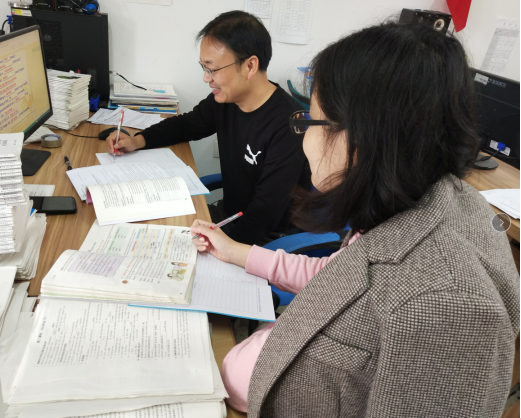英语初二备课组活动
发表日期:2020/10/23 18:26:04 出处:江宁区龙都初级中学 作者:张爱华 有2758位读者读过
活动时间 | 2020年10月23日 | 活动地点 | 英语组 |
参加人员 | 杨倩倩、濮正刚 | ||
活动主题 | 八上Unit 4 Do it yourself教学安排 | ||
活动方案 | 讨论本单元重难点,确定教学安排及教学进度,安排单元测验时间。
| ||
研讨记录 | 1,掌握本单元重点单词短语及句型,每周进行两到三次默写。 2,两周完成本单元所有新授课及练习讲解,并于下一周周一进行单元测验。 3,讨论期中复习安排,确定好时间,重难点,并组织一次模拟考试。
| ||
其他过程性材料 | 一、重点短语、句型: 1.Here are clear instructions 这儿是清楚的说明 2.What’s next ? 下一步是什么? 3.had better do sth 最好做某事 had better not do sth 最好不做某事 4.be popular among sb 受某人欢迎 5.It says... 上面写着...... 6.DIY = do it yourself 7.stand for 代表 8.repair or decorate things 修理或装饰东西 9.instead of (doing) sth 代替,而不是 10.pay sb to do sth 付钱给某人做某事 11.make some paper roses 做一些纸玫瑰 12.a pair of scissors 一副剪刀 13.make something new 做新的东西 14.be crazy about 着迷于 15.look terrible 看起来可怕(terribly adv.) 16.look/sound/ taste/ smell /feel(摸上去) + adj. 构成系表结构 17.He once (曾经) tried to put in a brighter light in his bedroom . once a year 一年一次 18.put in a brighter light 安装一盏更亮一些的灯 put in 安装,插话 19.make a mistake 犯错误 make mistakes 20.his whole house 他的整个房子 21.have a power cut 停电,供电中断 22.put up a picture on the wall 张贴一张照片在墙上 put away 把某物收好 23.hit the pipe 碰到管道 24.fill……with…… 用……装满…… be filled with = be full of装满,充满 26.keep on doing sth 不停地做某事 27.not only…but (also)…不但…而且…(就近原则)Not only you but also he speaks French well. 28.one end of the shelf 架子的一端 29.much higher than the other 远高于另一端 30.advise sb (not) to do sth 建议某人(不)做某事 give sb some advice 给某人一些建议 31.take a course in DIY 上/参加一个DIY的课程 32.attend lessons/ a meeting 上课/参加会议 33.fail to do sth 未能做某事 34.get better at DIY 在DIY方面变得更好 35.paint the walls blue 把墙涂成蓝色 36.make a sentence 造句 37.on the other side of the card 在卡片的另一边 learn more about 更多地了解 38.do a DIY job 做一件DIY工作 39.how to make a fruit salad 怎样做水果色拉 40.mix them together 把它们混合在一起 41.add some sugar to the milk 增加一些糖到牛奶里 42.cut...into pieces 把......切成片/块 43.some tips 一些提示 44.make sure 确信,确保 45.for example 例如 46.leave it in the air for some time 使它留在空气中一段时间 leave it to me 留给我吧 leave sth + 形容词/副词 使某物处于某种状态leave the door open 让门开着 leave the light on让灯开着 I’m leaving for Sydney next week.下周我动身到悉尼去. Can I leave my bike here? 我能把自行车存在这么? I left my homework at home.我把作业遗忘在家里了. 47.stop doing sth停止做某事 stop to do sth 停下来去做另外一件事 48.That’s correct 那就对了 49.do outdoor sports 做户外运动 50.stay at home all day 整天呆在家里 all night整夜 all day and all night 日日夜夜 51.sleep with all that noise 伴随着噪音睡觉 52.be able to fix the bicycle 能修理自行车 be (un)certain about sth.对某事(不)确定 I’m certain that I can fix it myself/ It’s certain that ... 53.fix the shelf 安装架子 54.all over the floor 遍地 55.tidy up 收拾,整理 56.right now 立刻,马上 57.decide to do sth 决定做某事 58.make her a birthday card 为她做生日卡片 59.buy / make / repair / prepare sb. sth. = buy / make / repair / prepare sth. for sb.给某人买/制作/修理/准备某物 60.by oneself = alone = on one’s own 独自 61.keep it secret 将它保密 62.help sb (to )do sth. = help sb with sth帮助某人做某事 63.have fun doing = have a good time doing 做某事很开心 64.It took me two hours to finish = I spent two hours finishing花费了我两个小时完成 65.go wrong 出错,出故障;走错路 66.keep doing sth.一直做某事 67.spell the words wrong 拼错单词spell(v)spelling (n) make spelling mistakes 犯拼写错误 68.colour the roses red 把玫瑰涂成红色(动词) colourful (形容词) 69.cut out 剪出 70.stick it on the cover (过去式stuck)将它粘在封面上 71.complete the card 完成卡片(v完成;adj 完全的----adv. completely完全地) 72.make sb sth = make sth for sb 为某人制作某物 73.make things from old clothes 用旧衣服做东西 二、语法: 一、动词过去式的不规则变化 cut---cut stick---stuck put---put buy---bought spell---spelled / spelt (详见教材附录:不规则动词原形、过去式、过去分词变化表) 二、名词 A、不可数名词,小心哦!glue electricity furniture (a piece of furniture) ham salad B、可数名词instruction tool mistake spoon rose sentence tape C、本身为复数名词 scissors( a pair of scissors) pants clothes shorts… D、意思决定可数还是不可数 tape 胶带(不可数),磁带(可数) 三、副词exactly clearly properly terribly however 四、介词 above----- There are clouds above the plane. (反义词:below) over----- There is a bridge over the river. (反义词:under) 五、否定前缀 un- in- im- certain—uncertain interesting—uninteresting comfortable—uncomfortable important--unimportant active—inactive correct—incorrect patient—impatient possible—impossible polite—impolite 六、否定后缀 -less useful—useless careful-- careless 祈使句 1. 祈使句的概念 表示请求、命令、建议、祝愿、邀请或要求的句子叫祈使句。用于祈使句句首的动词总是用原形,不能用其他形式。如: Shut the door! 把门关上! Have a cup of coffee! 喝杯咖啡吧! Let them go by train. 叫他们坐火车去吧。 祈使句的主语通常为第二人称(you),但一般都被省略,只有在特殊的情况下才把主语(you)补充出来。如: You be quiet! 你安静! You go and tell him, Chris. 克立斯,你去告诉他。 You wait here for a moment. 你在这儿等一会儿。 有时祈使句的主语也可以是everybody, somebody, anybody, nobody等不定代词。如: Stand up, everybody! 全体起立! Nobody move. 任何人都不许动。 2. 祈使句表示强调 为了加强祈使句的语气,我们通常是在祈使句的动词原形前加上助动词do,此时通常译为“一定”“务必”等。如: Do be careful. 务必要小心。Do have some more tea. 一定再喝点茶。Do let me go. 一定让我去。 副词never和always有时可用于祈使句句首,表示强调。如: Never do that again. 再不要这样做了。Always look in the mirror before starting to drive. 一定要先看看反光镜再开车。 3. 祈使句的否定式 构成祈使句否定式的方法很简单,那就是在动词原形前加don’t——不管祈使句所用的动词为什么性质动词,情况都是一样。如: Open the window. 把窗户打开。→Don’t open the window. 别把窗户打开。 Come next Monday. 下周星期一来。→Don’t come next Monday. 下周星期一别来。 对于以let us或let’s开头的祈使句,其否定式通常是在不定式之前放一个not。如: Let’s tell him the truth. 我们把实情告诉他吧。→Let’s not tell him the truth. 我们不要把实情告诉他。 4. 祈使句与连用please 为了使祈使句的语气变得委婉,我们可以在祈使句的句首或句末加上please——若加在句首,其后不用逗号;若加在句末,则通常会在please前加一个逗号。如: Step this way, please. 请这边走。Please type your letter. 请把你的信打出来。 Open the window, please. 请把窗户打开。 如果是否定祈使句,则通常将please加在don’t之前。如: Please don’t get angry. 请不要生气。Please don’t telephone before 8 a. m. 早8点以前请不要打电话。 5. 祈使句的时间概念 祈使句所表示的时间总是指将来,所以与它连用的句子原则上要用将来时态来与它呼应。如: Give me a hand, will you? 帮我一个忙,好吗? 由于give me a hand表示隐含将来意义,所以句中的will you 不能改为do you。 Try again and you will succeed. 你再试就会成功。 由于句中的try again隐含将来意义,所以句中用了you will succeed,而不是you succeed。 Don’t do that again or you’ll be in trouble. 别再干那个了,否则你会有麻烦。 句中的don’t do that again指的是以后不要再干那事了,由于隐含有将来意义,所所以句中用了you’ll be in trouble,而没有用you are in trouble。 6. 祈使句的省略 一般说来,祈使句总是要以动词原形开头,但是,在某些特殊情况下,我们可以只用一个词或短语来表示祈使句的意义。如: Just a few please. 请给几个就行了。A little more slowly please. 再慢一点。 A pound of butter. 给我一磅黄油。 Two teas and four coffees, please. 请来两杯茶和四杯咖啡。 had better, should, ought to 用法 had better, should, ought to 均为提建议型情态动词,常用来劝告别人去做某事,没有人称和数的变化,学习时应注意下列几点: 一、掌握基本用法 had better, should, ought to 含义及语气有所不同,请看下表:
二、掌握创新用法 should 可表竟然,强调惊讶的情绪。 I can't imagine this problem should be so easy. 我想像不出这个问题竟然这么容易。 had better 也可改为 had best ,其意义和用法不变。 I'm busy now, so you had best go there alone. 我现在很忙,所以你最好单独去那儿。 三、掌握句型变换方法 had better, should, ought to 均属于助动词,其疑问句、否定句及反意疑问句的构成均在自身形式上做变化。 1. 变成否定句方法 had better do 否定式为 had better not do, should do 否定式为 should not do 或 shouldn't do, ought to do 否定式为 ought not to do 或 oughtn't to do 。 2. 变成一般疑问句方法 had better, should, ought to 构成一般疑问句时应分别将 had, should, ought 提到句首,其肯定与否定回答为 had / hadn't, should / shouldn't, ought / oughtn't 。
| ||



 苏公网安备32011502010427号
苏公网安备32011502010427号